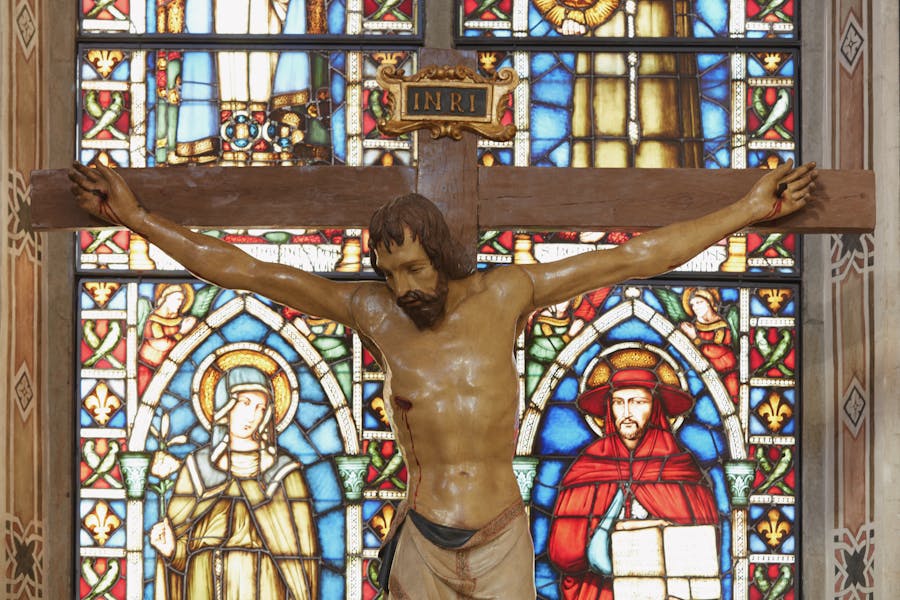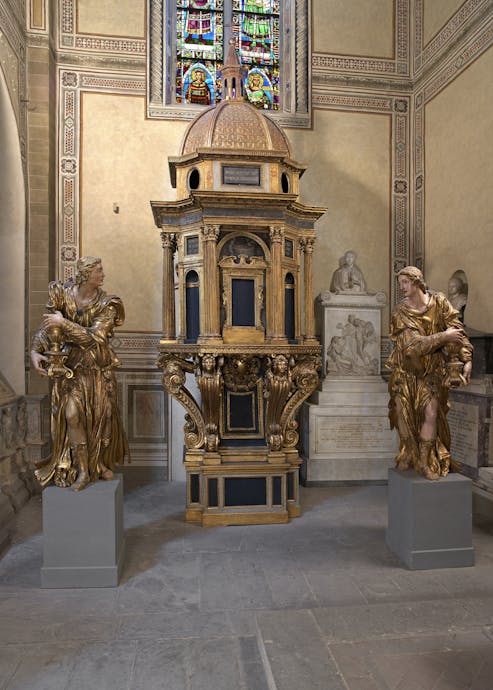
Bardi di Vernio Chapel
In order to allow this chapel to be built at the end of the north transept, it proved necessary to push through the church's perimeter wall just as the Baroncelli had done for their chapel in the south transept. Thus the chapel was built somewhat later than the other chapels giving directly onto the transept.
Comprising two cross-vaulted spaces, the chapel was founded by Piero de' Bardi to fulfill the last will and testament of his father Gulaterotto († 1331) who had left an enormous sum of money for the purpose. Gualterotto lies buried in a sumptuous tomb created c. 1337 and attributed to Agnolo di Ventura, which sits next to the splendid iron railing made by Conte di Lello in 1335.
Piero had acquired the castle of Vernio in 1332 and so his descendants had adopted the name "Bardi di Vernio" by which the chapel, dedicated to St Louis of Toulouse and St. Louis IX of France, is now known. The two saints are depicted in the stained-glass window, along with sainted kings dynastically related to Louis (who was the son of Charles II of Anjou, King of Naples, and of Mary Árpád, the daughter of King Stephen V of Hungary). Thus the stained-glass window, made by Taddeo Gaddi in collaboration with Ubaldo de Vitro and Gerardo Pillecti between 1332 and 1336, underscores the lineage, both sainted and royal, of Louis, who gave up the comforts of court life to become a Franciscan. The frescoes may also have reflected similar themes but unfortunately they have been lost, with the sole exception of the vaults attributed to Gaddi.
The dedication to St. Louis was especially relevant for the Franciscans in view of his recent canonisation, in 1317, but it was also strategic for the Bardi themselves for they were bankers to Robert of Anjou, the King of Naples and Louis' younger brother.
The demolition of the rood screen in 1566 to bring the church into line with the dictates of the Council of Trent entailed the transfer of Donatello's Crucifix to this chapel. The sculpture's new layout was completed in 1632 with the addition of an altarpiece depicting St. Louis and St. Agatha which Felice Ficherelli, known as Il Riposo, had painted as a backdrop for it. The altar was dismantled in 1913 and the painting is now in the Museo dell’Opera.

The church's renewal in the Neo-Gothic style in 1869 entailed the dismantlement of the large scenic apparatus framing the high altar and consisting of Giorgio Vasari's ciborium or canopy, dated some time between 1566 and 1569, and two torch-bearing angels completed by Bernardo Buontalenti in 1602. They were initially moved to the Cenacolo before being transferred to this chapel, where they may still be seen today.

Giorgio Vasari, Ciborium Canopy and Two Angels, second half of the 16th century. Santa Croce, north transept, Bardi di Vernio Chapel